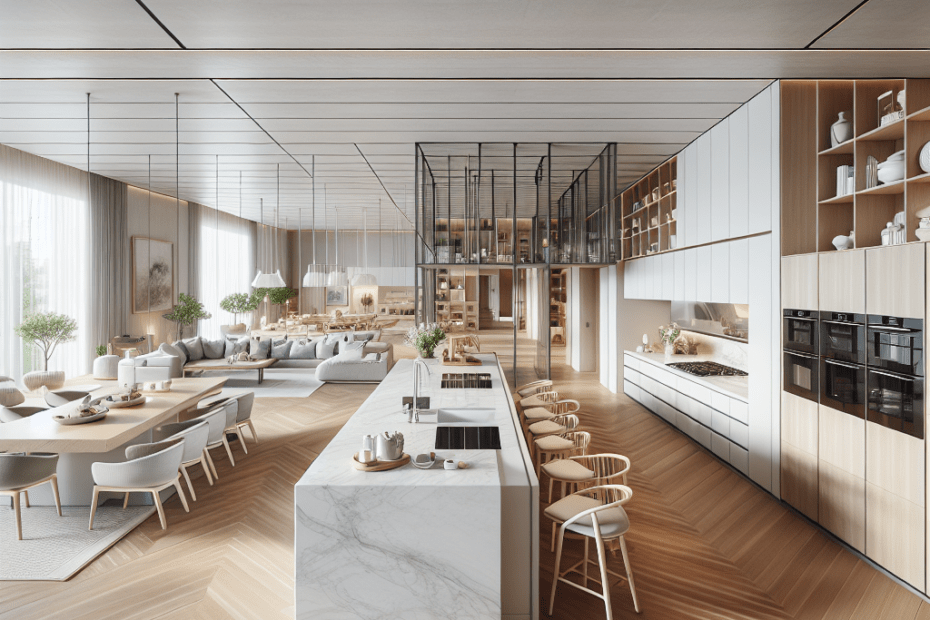“`html
Embracing Open-Concept Kitchen Design
Many homeowners are opting for open-concept kitchen designs for their new homes and renovation projects. An open-concept kitchen creates a cohesive flow between cooking, dining, and living spaces. This type of design is not only aesthetically pleasing but also functional for day-to-day living and entertaining. The trend towards open spaces is evident in home improvement statistics, with the National Association of Home Builders reporting that nearly 70% of kitchen renovation projects now incorporate open designs.
Understanding Open-Concept Kitchen Design
An open-concept kitchen design does away with walls and barriers that often confine the kitchen to its own space. Instead, it combines different areas of the home to create one large, shared space. This approach is not just about aesthetics; it’s about creating a seamless flow that enhances both space and function.
Key Elements to Consider
When planning an open-concept kitchen, it is crucial to focus on the following elements:
- Layout: The layout of an open kitchen is vital for ensuring smooth movement and interaction between spaces. Islands or peninsulas often serve as the central piece, acting as a partition that provides ample counter space and seating.
- Lighting: Proper lighting contributes to the ambiance and functionality of the kitchen. Natural light sources should be maximized, complemented by task and ambient lighting to define the space.
- Materials: Harmonizing materials across the open space creates visual cohesion. Countertops, cabinetry, and flooring should blend seamlessly to avoid visual breaks.
- Color Scheme: Using a consistent color palette helps tie the spaces together. Neutral tones or accents can work well if they maintain the interconnectedness of different zones.
Creating Flow in an Open-Concept Kitchen
For truly seamless integration, flow is paramount. Here are some ways to achieve it:
| Technique | Description |
|---|---|
| Transitional Spaces | Use rugs or flooring changes to guide movement between areas without disruptive barriers. |
| Consistent Decor | Keep furniture styles and decor elements consistent across the kitchen, dining, and living areas. |
| Functional Zones | Designate specific zones for cooking, eating, and lounging to organize the open space. |
Overcoming Challenges in Open-Concept Kitchen Design
While beautiful, open-concept kitchens can come with challenges:
- Noise: With fewer walls, sound can travel unimpeded. Consider soundproofing materials or strategic furniture placement to mitigate noise.
- Odors: Cooking smells can easily spread to adjacent areas. A high-quality range hood is essential to minimize this issue.
Benefits of Open-Concept Kitchen Design
The benefits of an open-concept kitchen are numerous. They open up the home and make it feel larger and more inviting. This design also facilitates social engagement by keeping family and guests connected, even during meal prep. For families, it enhances the ability to supervise children from common spaces.
Statistics Supporting Open-Concept Kitchens
In recent years, the demand for open-concept kitchens has been on the rise. A survey by the Houzz Kitchen Trends Study indicated that nearly 57% of homeowners who remodeled their kitchens chose an open-driven layout, prioritizing connectivity between spaces.
Key Takeaways
- Open-concept kitchens create seamless, spacious, and functional spaces.
- Focus on layout, lighting, materials, and color integration for cohesive design.
- Mitigate challenges such as noise and odor for a better living environment.
- This style enhances social engagement and makes indoor spaces feel more expansive.
- The trend is strongly reflected in remodeling statistics, showing homeowners’ preference for open designs.
FAQ: Open-Concept Kitchen Design
- What is an open-concept kitchen?
An open-concept kitchen is a design that integrates the kitchen with adjacent living and dining areas by removing walls and creating one large open space.
- Why choose an open-concept design?
Open-concept designs improve the visual space, enhance social interaction, and create a more flexible layout for living and entertaining.
- How can noise be managed in an open-concept kitchen?
Consider incorporating sound-absorbing materials and strategic furniture placement to reduce noise transference between spaces.
- What are the lighting requirements for an open-concept kitchen?
Maximize natural light, and add ambient and task lighting to define different zones effectively.
- Can small spaces accommodate an open-concept kitchen?
Yes, even small spaces can benefit from an open-concept design by maximizing each area’s functional use and creating a sense of expansiveness.
“`
